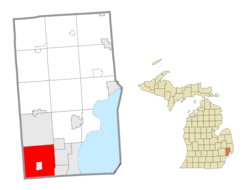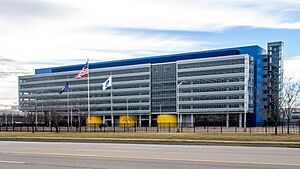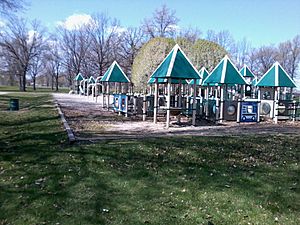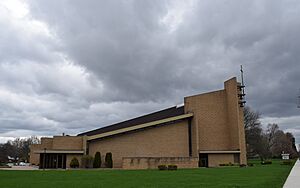Warren, Michigan facts for kids
Quick facts for kids
Warren, Michigan
|
||
|---|---|---|

Warren Civic Center (2020)
|
||
|
||
| Motto(s):
A Safe and Clean City
|
||

Location of Warren in Macomb County, Michigan
|
||
| Country | United States | |
| State | Michigan | |
| County | Macomb | |
| Founded | 1830 | |
| Incorporated (village) | 1893 | |
| Incorporated (city) | January 1, 1957 | |
| Government | ||
| • Type | Strong mayor | |
| Area | ||
| • City | 34.434 sq mi (89.184 km2) | |
| • Land | 34.377 sq mi (89.036 km2) | |
| • Water | 0.022 sq mi (0.057 km2) | |
| Elevation | 623 ft (190 m) | |
| Population
(2020)
|
||
| • City | 139,387 | |
| • Estimate
(2023)
|
136,655 | |
| • Rank | US: 204th MI: 3rd |
|
| • Density | 3,975.63/sq mi (1,535.00/km2) | |
| • Urban | 3,776,890 (US: 12nd) | |
| • Metro | 4,342,304 (US: 14th) | |
| Time zone | UTC−5 (Eastern (EST)) | |
| • Summer (DST) | UTC−4 (EDT) | |
| ZIP Codes |
48088, 48089, 48090, 48091, 48092, 48093, 48397
|
|
| Area code(s) | 586 | |
| FIPS code | 26-84000 | |
| GNIS feature ID | 1615781 | |
| Sales tax | 6.0% | |
Warren is a city in Macomb County, Michigan. It's a large suburb of Detroit, located about 13 kilometers (8 miles) north of downtown Detroit. In 2020, Warren had a population of 139,387 people. This makes it the biggest community in Macomb County and the third-largest city in Michigan. It's also Detroit's largest suburb.
Warren is home to many important businesses. These include the General Motors Technical Center, the United States Army Detroit Arsenal, and the headquarters of Asset Acceptance. The Detroit Arsenal is where the United States Army TACOM Life Cycle Management Command and the Tank Automotive Research, Development and Engineering Center (TARDEC) are located.
Contents
History of Warren, Michigan
The first settlement in the area was called Beebe's Corners. It was founded in 1830 by Charles Groesbeck. This spot was a stop for carriages traveling between Detroit and Utica. It had a distillery, a mill, a tavern, and a trading post.
In 1837, the area around Beebe's Corners became Warren Township. It was first named Hickory, then Aba, and finally Warren. The township was named after Reverend Abel Warren, a preacher from New York. He was the first licensed preacher in Michigan and traveled widely, helping pioneers in the area. Another story says the city was named after General Joseph Warren, who died at the Battle of Bunker Hill.
How Warren Became a City
The settlement officially became the Village of Warren on April 28, 1893. It was a small village that grew slowly at first. By 1950, it had only 727 people. However, the larger area around it grew much faster. This growth happened because of big factories being built. These included Chrysler's Truck Assembly plant in 1938, the Detroit Arsenal Tank Plant in 1940 (to help with World War II), and the General Motors Technical Center built between 1949 and 1956.
The Village of Warren and most of Warren Township, along with Van Dyke, officially became a city in 1957. The city of Center Line had already become a city from Warren Township earlier. Between 1950 and 1960, Warren's population jumped from 42,653 to 89,426. This huge growth was due to the "Baby Boom" after World War II and people moving from Detroit. By 1970, the city's population reached a high of 179,000.
Over time, Warren's population has become much more diverse. In 1970, almost all residents were white. By 2000, less than 3% of the population was Black. However, by 2020, the Black population had grown to over 20%, and the Asian population had doubled.
Mayors of Warren, Michigan
Here is a list of the people who have served as mayor of Warren. The current mayor is Lori Stone. Mayoral elections in Warren are non-partisan, meaning candidates don't run as members of a political party.
| # | Mayors | Mayoral elections | Start of term | End of term |
|---|---|---|---|---|
| 1 | Arthur J. Miller | D | January 1, 1957 | December 30, 1960 |
| 2 | Louis A. Kelsey | D | January 1, 1961 | April 10, 1961 |
| 3 | William (Bill) Shaw | D | April 11, 1961 | April __, 1967 |
| 4 | Ted Bates | D | April __, 1967 | November 6, 1981 |
| 5 | James R. Randlett | D | November 7, 1981 | November 5, 1985 |
| 6 | Ronald L. Bonkowski | D | November 6, 1985 | November 7, 1995 |
| 7 | Mark A. Steenbergh | D | November 7, 1995 | November 9, 2007 |
| 8 | James R. Fouts | D & I | November 9, 2007 | November 17, 2023 |
| 9 | Lori M. Stone | Democratic | November 18, 2023 | Current |
Geography of Warren
Warren is a central city in the Metro Detroit area. It covers about 89 square kilometers (34.4 square miles). Most of this area is land, with a small amount of water. The city is shaped like a square, about 6 miles by 6 miles. It stretches from 8 Mile Road in the south to 14 Mile Road in the north.
Warren is located in the southwest corner of Macomb County. The city of Center Line is a small city completely surrounded by Warren. Warren shares its southern border with Detroit. Other cities next to Warren include Hazel Park and Madison Heights to the west, Sterling Heights to the north, and Fraser, Roseville, and Eastpointe to the east.
Warren's Climate
Warren has a humid continental climate. This means summers are somewhat hot, with temperatures often going above 32°C (90°F). Winters are cold, with temperatures staying below freezing for many days. It can also get very cold, sometimes dropping to -18°C (0°F) or lower.
| Climate data for Warren, Michigan (Eastpointe station) | |||||||||||||
|---|---|---|---|---|---|---|---|---|---|---|---|---|---|
| Month | Jan | Feb | Mar | Apr | May | Jun | Jul | Aug | Sep | Oct | Nov | Dec | Year |
| Mean daily maximum °F (°C) | 32.8 (0.4) |
35.8 (2.1) |
44.7 (7.1) |
58.3 (14.6) |
69.7 (20.9) |
80.0 (26.7) |
84.2 (29.0) |
81.7 (27.6) |
74.8 (23.8) |
62.3 (16.8) |
49.0 (9.4) |
36.5 (2.5) |
59.1 (15.1) |
| Daily mean °F (°C) | 25.5 (−3.6) |
27.3 (−2.6) |
35.0 (1.7) |
47.2 (8.4) |
58.6 (14.8) |
68.9 (20.5) |
73.3 (22.9) |
71.3 (21.8) |
63.9 (17.7) |
52.1 (11.2) |
40.8 (4.9) |
29.7 (−1.3) |
49.5 (9.7) |
| Mean daily minimum °F (°C) | 18.2 (−7.7) |
18.8 (−7.3) |
25.3 (−3.7) |
36.0 (2.2) |
47.5 (8.6) |
57.7 (14.3) |
62.3 (16.8) |
60.8 (16.0) |
52.9 (11.6) |
41.9 (5.5) |
32.5 (0.3) |
22.9 (−5.1) |
39.7 (4.3) |
| Average precipitation inches (mm) | 1.86 (47) |
1.82 (46) |
2.27 (58) |
3.07 (78) |
3.23 (82) |
3.38 (86) |
3.22 (82) |
3.38 (86) |
3.45 (88) |
2.75 (70) |
3.05 (77) |
2.49 (63) |
33.97 (863) |
| Source: NOAA (normals 1981–2010) | |||||||||||||
Major Roads in Warren
Several important roads run through Warren:
 I-696 (Walter P. Reuther Freeway) goes east and west through the city.
I-696 (Walter P. Reuther Freeway) goes east and west through the city. M-53 (Van Dyke Avenue) runs north and south and roughly divides the city in half. It's also known as the Earle Memorial Highway.
M-53 (Van Dyke Avenue) runs north and south and roughly divides the city in half. It's also known as the Earle Memorial Highway. M-97 (Groesbeck Highway) is in southeast Warren. It's a fast, wide road that connects to northern Macomb County.
M-97 (Groesbeck Highway) is in southeast Warren. It's a fast, wide road that connects to northern Macomb County. M-102 (8 Mile Road) is the city's southern border. It's also the line between Macomb and Wayne counties.
M-102 (8 Mile Road) is the city's southern border. It's also the line between Macomb and Wayne counties.
Mound Road is another important north-south road. For east-west travel, people mainly use the mile roads. These include 8 Mile Road, 11 Mile Road (which is a service road for I-696), and 14 Mile Road, which is Warren's northern border.
 |
Troy | Sterling Heights | Clinton Township Fraser |
 |
| Madison Heights Hazel Park |
Roseville Eastpointe |
|||
Center Line |
||||
| Detroit |
Population of Warren
| Historical population | |||
|---|---|---|---|
| Census | Pop. | %± | |
| 1900 | 890 | — | |
| 1910 | 2,346 | 163.6% | |
| 1920 | 6,780 | 189.0% | |
| 1930 | 24,024 | 254.3% | |
| 1940 | 23,658 | −1.5% | |
| 1950 | 42,653 | 80.3% | |
| 1960 | 89,246 | 109.2% | |
| 1970 | 179,260 | 100.9% | |
| 1980 | 161,134 | −10.1% | |
| 1990 | 144,864 | −10.1% | |
| 2000 | 138,247 | −4.6% | |
| 2010 | 134,056 | −3.0% | |
| 2020 | 139,387 | 4.0% | |
| 2023 (est.) | 136,655 | 1.9% | |
| U.S. Decennial Census 2020 Census |
|||
Population in 2020
In 2020, Warren had 139,387 people living in the city. There were 54,933 households and 34,601 families. The population density was about 1,535 people per square kilometer (4,055 per square mile).
The city's population included:
- 62.4% White
- 20.4% African American
- 0.3% Native American
- 10.3% Asian
- 1.0% from other races
- 5.7% from two or more races.
- People of Hispanic or Latino origin made up 2.6% of the population.
Between 2010 and 2020, the number of Asian residents in Warren doubled. This was largely due to more Hmong and Bangladeshi people moving to the city.
Household Information (2022)
In 2022, there were 54,483 households in Warren. Each household had about 2.52 people on average. The average rent was $1,139. The average household income was $61,633. About 71.1% of homes were owned by the people living in them. About 13.5% of the city's population lived below the poverty line.
About 63.7% of the population was employed. Also, 19.9% of people had a bachelor's degree or higher, and 86.3% had a high school diploma.
The most common ancestries reported by residents were German (11.0%), Polish (8.8%), Irish (6.8%), Italian (5.8%), and English (5.2%).
Economy of Warren
Warren is a hub for many large companies and government facilities.

Top Employers in Warren
Here are the top five employers in Warren, based on a 2022 report:
| # | Employer | # of employees |
|---|---|---|
| 1 | General Motors | 23,823 |
| 2 | Government of the United States | 7,800 |
| 3 | Stellantis | 5,523 |
| 4 | Ascension Health | 2,407 |
| 5 | Lipari Foods | 1,300 |
Neighborhoods in Warren
Warren is divided into several neighborhoods, each with its own character.
Southeast Warren (48089)
This area includes Belangers Garden, Berkshire Manor, Piper Van Dyke, Warrendale, and part of Warren Woods. In 2009, about 33,031 people lived here. Most homes are bungalows built after World War II. North of Stephens Road, many homes are brick ranch style, built after 1960. This area also has several industrial parks.
Southwest Warren (48091)
This part of Warren includes the Beierman Farms and Fitzgerald neighborhoods. In 2009, it had about 30,876 residents.
Northeast Warren (48090, 48093, 48088)
This large area includes Bear Creek, Bella Vista Estates, Downtown, Fairlane Estates, Lorraine, Northampton Square, and parts of Warren Woods and Warren Con. In 2009, about 45,492 people lived here.
Northwest Warren/Warren Con. (48092)
This area covers the western part of the Warren Con neighborhood. In 2009, its population was about 24,997.
Education in Warren
Warren has many schools, from public to private, and even colleges.
Public Schools in Warren
Six public school districts serve Warren:
- Center Line Public Schools
- Eastpointe Community Schools
- Fitzgerald Public Schools
- Van Dyke Public Schools
- Warren Consolidated Schools
- Warren Woods Public Schools
The Macomb Intermediate School District helps oversee these individual school districts.
Some of the high schools serving Warren are:
- Warren Woods Tower High School
- Paul K. Cousino Sr. High School
- Lincoln High School
- Warren Mott High School
- Fitzgerald High School
- Center Line High School (in Center Line)
- Eastpointe High School (in Eastpointe)
There is also a charter school called Michigan Collegiate.
Private Schools in Warren
- Crown of Life Lutheran School
- De La Salle Collegiate High School (for boys)
- Regina High School (for girls)
Colleges and Universities
- Macomb Community College (South Campus)
- Davenport University
- Wayne State University's Advanced Technology Education Center
Public Libraries in Warren
The Warren Public Library system has one main library and three branches. The Civic Center Library is located inside the city hall. The Arthur Miller Branch is in the Warren Community Center. The other two branches are the Maybelle Burnette Branch and the Dorothy Busch Branch.
In 2010, the three branch libraries temporarily closed but reopened later that year after a public vote approved funding.
Religion in Warren
Warren is home to many different places of worship.
The Roman Catholic Archdiocese of Detroit oversees several Catholic Churches in Warren. For example, Our Lady of Grace Vietnamese Parish moved to Warren in 2011 and merged with St. Cletus Church. This happened because Our Lady of Grace needed a larger space, and St. Cletus had a smaller congregation.
Other Catholic parishes include St. Faustina Parish, St. Louise de Marillac Parish, St. Mark Parish, St. Martin de Porres Parish, and St. Mary-Our Lady Queen of Families Parish. Many of these parishes were formed by merging smaller churches to better serve the community.
Culture and Fun in Warren
Warren offers many ways for residents to have fun and enjoy their city.
The City of Warren has a Department of Parks and Recreation. This department manages the Aquatic, Community, and Fitness Centers, along with 24 parks.
The Warren Symphony Orchestra performs several concerts each season. The city also built a new community center in 2003 where the old Warren High School used to be.
There is also a Cultural Commission with nine members who help promote arts and culture in the city.
Universal Mall, an indoor shopping mall built in 1965, was torn down in 2009 to make way for a new outdoor shopping center.
The Italian American Cultural Society (IACS) was in Warren for 20 years before moving to Clinton Township in 2004.
Historical Markers in Warren
There are nine official Michigan historical markers in Warren. These markers tell important stories about the city's past:
- Detroit Arsenal Tank Plant: This plant built many Sherman tanks during World War II and M1 Abrams tanks until 1996.
- Detroit Memorial Park Cemetery: This is where inventor Elijah McCoy and former Supremes singer Florence Ballard are buried.
- General Motors Technical Center: A major research and development center.
- Warren Truck Assembly: An important vehicle manufacturing plant.
- Governor Alexander Joseph Groesbeck: Marks the birthplace of a former Michigan governor.
- John Theisen House
- Village of Warren
- Warren Township District No. 4 School
- Warren Union Cemetery
Two other markers are very close to Warren, in Center Line, Michigan, and are also important to the area's history:
- St. Clement Catholic Church
- St. Clement Catholic Cemetery
The Warren Historical and Genealogical Society has also placed about two dozen other markers around the city.
Famous People from Warren
Many notable people have connections to Warren, Michigan:
- Alex Avila: Major League Baseball catcher.
- Bruiser Brody: Professional wrestler.
- Jim Daniels: Writer.
- Michael Danna: NFL player.
- Danny Dekeyser: Retired NHL player.
- Eminem: Famous rapper and recording artist.
- Denny Felsner: Former NHL player.
- Norman Geisler: Christian theologian and philosopher.
- Harry Gozzard: Jazz musician.
- Alex J. Groesbeck: Former governor of Michigan.
- Bryan Herta: Racing driver.
- Grant Hochstein: Figure skater.
- Matt Hunwick: NHL player.
- I See Stars: An electronicore band formed in Warren.
- Joe Kopicki: NBA player.
- Mitch Ryder: Rock and roll singer.
- John Smoltz: MLB pitcher and Hall of Famer.
- Tom Stanton: New York Times bestselling author.
- Matt Taormina: NHL player.
- Blair Underwood: Actor.
- Doug Weight: Retired NHL player.
- Johnny White: Racing driver.
- John Wojciechowski: NFL player.
Images for kids
See also
 In Spanish: Warren (Míchigan) para niños
In Spanish: Warren (Míchigan) para niños








